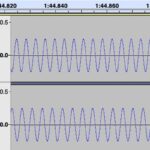Binaural beats music is scientifically proven as a transformative therapy, but there are a number of factors that can hinder efficacy.
If you aren't feeling the benefits that you should be, one or more of the following is probably the reason why.
1. Incorrectly Produced Tracks
Amateur tracks, generally found on platforms like YouTube and some websites, often lack the proper creation of the binaural beats. The Frequency Response Process (FRP), which is integral to the effectiveness of binaural beats, relies on accurate creation.
FRP occurs when the frequencies sent from the left and right channels of headphones combine within your auditory system. Once combined, the brain is entrained to the desired frequency.
If the person creating the track does not understand how to correctly create binaural beats, the listening experience is flawed from the outset. For optimal results, it is crucial to choose professionally produced tracks.
2. Inaccurate Target Frequency
Choosing a track with the wrong frequency can lead to unintended outcomes. For instance, what is seemingly a relaxing track may actually be using a higher frequency than it should be, which results in stimulating rather than calming the brain down.
What we have seen many times over the past decade is tracks being posted online, titled with popular frequency numbers. However, when tested, the track itself does not actually contain the said frequency. It is just a piece of music (usually from a music library) intended to gain a high volume of views.
Ensuring that the chosen frequency aligns with the desired mental state is key for the intended beneficial outcome.
Knowledge of what frequency to use comes with experience. It is gained as a result of understanding the brainwave spectrum and scientific data, and also considerable experience in sound therapy and the production of this type of music.
3. Not Using Headphones
Obvious, maybe, but many people don't know that binaural beats require headphones to create the necessary process of entrainment. Without headphones, the beats won't interact correctly, diminishing their impact.
Binaural beats work through a perceptual phenomenon that occurs in the brain when it processes two slightly different auditory frequencies presented separately to each ear.
As a result of receiving these two tones from the left and right channels of the headphones, the brain perceives a third tone, known as the binaural beat, which is the mathematical difference between the two presented frequencies. The brain then follows along at this frequency.
Without headphones, this process doesn't happen.
Investing in quality headphones (see here) can enhance the potential of brainwave entrainment.
4. Preventing the Desired Outcome
To maximize the effectiveness of binaural beats, the listening environment should align with the intended outcome.
For example, if you are preparing for sleep, engaging in relaxation activities simultaneously can assist the process. In contrast, stimulating the brain with unrelated activities, such as watching a movie or scrolling on the phone, counteracts the desired effects.
In short, always engage in an activity conducive to the outcome you are trying to achieve.
5. Disharmony & Dislike of the Music
Poorly produced tracks that fail to integrate beats harmoniously with the music overlay create dissonance (disharmony). This repels the brain rather than entice it to want to listen. In addition, a poorly chosen sound design will produce the same problem.
Here you have a situation where you want to listen to this supposed beneficial healing music, but it doesn't sound pleasant to your ears.
Therefore, choosing tracks with sound designs that resonate with personal taste enhances engagement and increases the likelihood of a positive experience.
It is for this reason that professional producers create tracks designed to appeal to a broad spectrum of users. Gentle, ear-pleasing ambient / meditation-style music, without heavy instrumentation is best suited.
In addition, the music must be mixed professionally, to ensure good balance, cohesion, and dynamics. The music is usually mastered at a low volume, so as to avoid harshness









